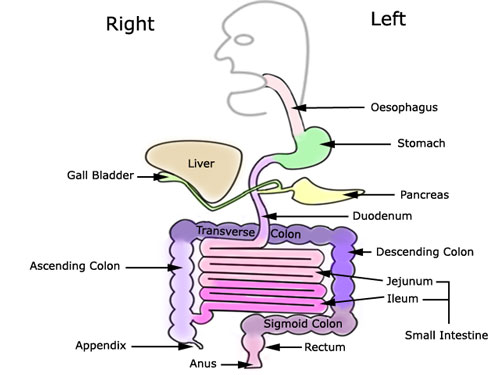- What is Oesophageal Cancer (Adenocarcinoma of the Oesophagus)
- Statistics on Oesophageal Cancer (Adenocarcinoma of the Oesophagus)
- Risk Factors for Oesophageal Cancer (Adenocarcinoma of the Oesophagus)
- Progression of Oesophageal Cancer (Adenocarcinoma of the Oesophagus)
- Symptoms of Oesophageal Cancer (Adenocarcinoma of the Oesophagus)
- Clinical Examination of Oesophageal Cancer (Adenocarcinoma of the Oesophagus)
- How is Oesophageal Cancer (Adenocarcinoma of the Oesophagus) Diagnosed?
- Prognosis of Oesophageal Cancer (Adenocarcinoma of the Oesophagus)
- How is Oesophageal Cancer (Adenocarcinoma of the Oesophagus) Treated?
What is Oesophageal Cancer (Adenocarcinoma of the Oesophagus)
Oesophagus Cancer (cancers of the oesophagus) may be of the Adenocarcinoma type, and usually arise from the glandular cells of the epithelium which lines the lower part of the gullet. The oesophagus is the organ that connects the mouth to the stomach. It is a muscular tube lined with epithelium. The sphincter at the bottom of the oesophagus stops acid refluxing up the oesophagus from the stomach.

Statistics on Oesophageal Cancer (Adenocarcinoma of the Oesophagus)
Oesophagus cancer is relatively uncommon, accounting for only 10% of oesophageal cancers, and occurs with increasing age with sex incidence being more common in men. Geographically, the oesophagus tumour is found worldwide.
Risk Factors for Oesophageal Cancer (Adenocarcinoma of the Oesophagus)
Barrett’s oesophagus (the lining at the lower end of the gullet has changed from being skin-like to being like the skin of the stomach – smooth muscle similar to the small intestine).
Progression of Oesophageal Cancer (Adenocarcinoma of the Oesophagus)
The oesophagus cancer tumour spreads by local invasion of the muscular layer of the oesophagus. Oesophagus caner may directly invade the lymphatics adjacent to the oesophagus and also directly invade the mediastinum, pericardium and trachea. Spreading via the blood stream can lead to the other major organs such as lung and liver with bone metastases being less common.
How is Oesophageal Cancer (Adenocarcinoma of the Oesophagus) Diagnosed?
General investigations into oesophagus cancer may show anaemia due to dietary deficiencies or chronic disease. Liver function may be abnormal with metastatic disease.
Prognosis of Oesophageal Cancer (Adenocarcinoma of the Oesophagus)
The prognosis of patients with oesophageal carcinoma is poor, and as such, management focuses on symptom control. Total oesophagus cancer surgical resection is possible in only 40% of cases, and have post-operative mortality rates approaching 10%; the 5 year post-operative survival rate is about 20% for oesophagus cancer patients. The outcome of primary radiation therapy is similar to that of radical surgery, though less effective in relief of obstructive patients.
How is Oesophageal Cancer (Adenocarcinoma of the Oesophagus) Treated?
With oesophagus cacner the best chance of cure is surgical resection before any lymph node spreading has occurred. Sometimes, combined chemo irradiation is given prior to surgery. Significant reductions in tumour mass size have been achieved in 15-25% of oesophagus cancer patients treated with drug combinations that included cisplatin.
Combination chemotherapy and radiation therapy produces a better response than radiation therapy alone. However, randomised trials have not effectively shown that the use of pre-operative chemotherapy and radiotherapy followed by surgical resection prolongs survival.
For incurable oesophagus cancer patients with obstructive complications, approaches to palliation include endoscopic dilation, gastronomy or jejunostomy (surgical creation of an opening into the abdominal wall for artifical feeding) and endoscopic placement of a metal stent to bypass the tumour. Endoscopic fulgration (destroying tissue via endoscopy) with laser appears to be the most promising. Improvement in oesophagus cancer symptoms is an important measurement. Specific monitoring may take place through repeat endoscopies.
The oesophagus cancer symptoms that may require attention are Dysphagia (difficulty in swallowing). This may be well palliated with endoscopy with dilatation, insertion of a stent, photosensitiser plus laser. Somatic pain or visceral pain from local tumour effects may also require treatment. Aspiration pneumonia is a fairly frequent complication. This may be treated on its own merits accordingly to the stage of the oesophagus cancer.
All content and media on the HealthEngine Blog is created and published online for informational purposes only. It is not intended to be a substitute for professional medical advice and should not be relied on as health or personal advice. Always seek the guidance of your doctor or other qualified health professional with any questions you may have regarding your health or a medical condition. Never disregard the advice of a medical professional, or delay in seeking it because of something you have read on this Website. If you think you may have a medical emergency, call your doctor, go to the nearest hospital emergency department, or call the emergency services immediately.







